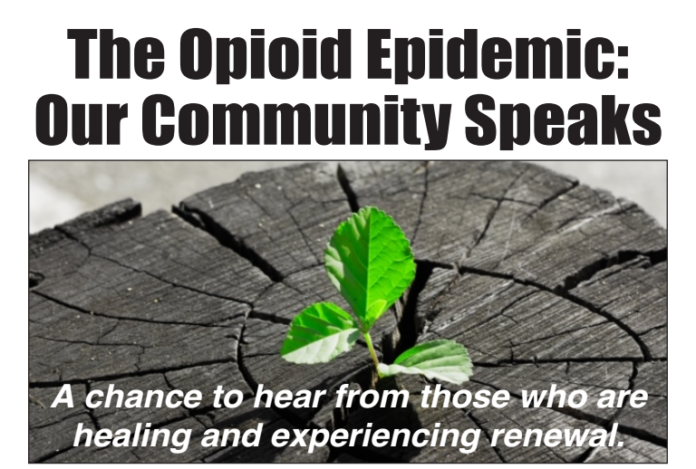The Bowen Center held another opioid discussion Thursday, this time in Syracuse.
The event was emceed by Syracuse Bowen Center Director Mike Murphy and included speakers from law enforcement, Department of Child Services, Bowen Center and a speaker in recovery.
Syracuse Police Chief Jim Layne spoke about the trend in drugs he’s seen in his experience, as well as what the Syracuse Police Department is trying to do to get drugs out of the community.
“When I first started in 2001, it was just coming up cocaine, crack that was just starting to come in,” he said. “It came in for a short while.”
Then after a few years, they started seeing meth and the things that came with it, such as “the cookie.”
“So we started learning about that,” he said. “And when we started learning about that, they switched it up on us” by using different ingredients, which made it more difficult for law enforcement to detect the drug. Layne said the department then started dealing with pain killers, then they started seeing issues with heroin.
“And that’s where we are now,” he said, adding the drug issue he’s seen has gotten worse.
The thing he wanted people to get out of the event was to get people help.
“If you have prescription medication at home, it doesn’t matter what kind of medication, as long as it’s not liquid, needles or capsules with liquid in it,” people can put medication in a drug box in front of the Syracuse Police Department, he said. This is a way to get rid of the drugs so it doesn’t fall into the wrong hands.
He said the police department gets about 10 pounds of drugs from that box a month. Those drugs are separated and transported to Warsaw and loaded up to be incinerated.
Amanda Herendeen, who has been with the Department of Child Services for about 12 years, spoke about how drugs affect child services. She spoke in regards to data obtained from Noble County, as that’s where she works.
About 45% of the department’s case load is due to parental drug use. Some of the impacts opioid use has on parenting includes poor decision making, failure to meet the basic needs of the child, physical agitation and poor coordination.
The department’s primary goal is to ensure safety within the family. Some of the treatment options used by DCS with dealing the drug abuse includes early interventions, problem-solving courts or family preservation court, halfway houses or inpatient programs and medically assisted treatment programs. If the department does have to take the child out of the house, the department tries to put the child in the care of a relative, the other parent or foster care, depending on the situation.
“We realize that relapses are part of recovery,” she said. “You don’t develop an addiction overnight and it’s not going to go away overnight.”
She also explained that if a child is born positive with drugs, it doesn’t automatically mean the child is going to be taken away from the family, as there are several factors that go into a decision like that.
Benny Powell, Bowen Center assistant director to recovery services, spoke about services the Bowen Center had.
Bowen gives care and treatment for things that include depression, substance use disorders, gambling addiction and obsessive compulsive disorder. Services include medicated-assisted treatment, group and individual therapy, transitional living, school-based services and emergency services.
Powell said less than 1% of those that are in the center are self-referred, with the majority court-ordered.
Dr. Carolyn Greer, medical director of the Bowen Recovery Center, Fort Wayne, spoke about treatment at the center. The Recovery Center is a specialized place for opioid treatment, which people usually associate with methadone treatment, but that’s not always the case.
“We have a lot of medicines that treat opioid abuse,” she said.
She also talked about the risks of drug use.
The biggest risk factor for overdose is when people leave treatment or jail. When treating patients, The Recovery Center does not use detox to treat them.
There are also things that put people at risk of drug abuse, which are genetics, trauma and early exposure.
Mary Gerard, vice president of human resources at the Bowen Center, spoke about how to help in the opioid crisis.
“There’s so many ways you can help,” she said. Bags and refrigerater magnets were given out listing 10 things community members can do about the opioid crisis in the county. Gerard said she would let the bags and magnets speak for themselves, but there are more than 10 ways to help.
Among the ways listed on the bags and magnets were offering safe rides home, questioning providers who prescribe excessive amounts of pain medication, educate employers and other organizations about the importance of having Narcan, collecting and disposing all unused prescription in people’s home and educating people’s children, grandchildren and their friends about the opioid crisis.
Greer also gave ways the community can help, which included learning the symptoms of opioid overdose, learning how to use Narcan, locking up any opioid prescriptions and recommending anyone with an opioid prescription have a Narcan kit.
Phil, 32, a man who said he began using drugs at 9, shared his story as he did at the event at Center Lake Pavilion Jan. 15.
Gerard said she wanted people to leave the event Thursday with a spark of wanting to do something.





